Dementia in Australia: Analyzing the Impact of Predicted Increase
VerifiedAdded on 2023/01/13
|7
|1408
|67
Report
AI Summary
This report provides an analysis of the projected increase in dementia cases in Australia, examining its impact on the healthcare system and the broader population. The report begins with an introduction to dementia, defining it as a decline in cognitive functions and highlighting its status as a leading cause of death in Australia. The main body of the report delves into the predicted increase in dementia cases, citing statistics and projections through 2058, and discussing the increasing financial burden on the healthcare system. It explores the impact of dementia on individuals, families, and the economy, including the rise in deaths, the increasing number of carers, and the growing financial costs. The report also analyses the impact on different age groups and genders. It concludes by summarizing the findings, emphasizing the need for proactive measures to address the rising rates of dementia and mitigate its negative effects on Australian society. The analysis draws on various sources including journal articles, and online reports to support its conclusions. This assignment is a great resource for students on Desklib.
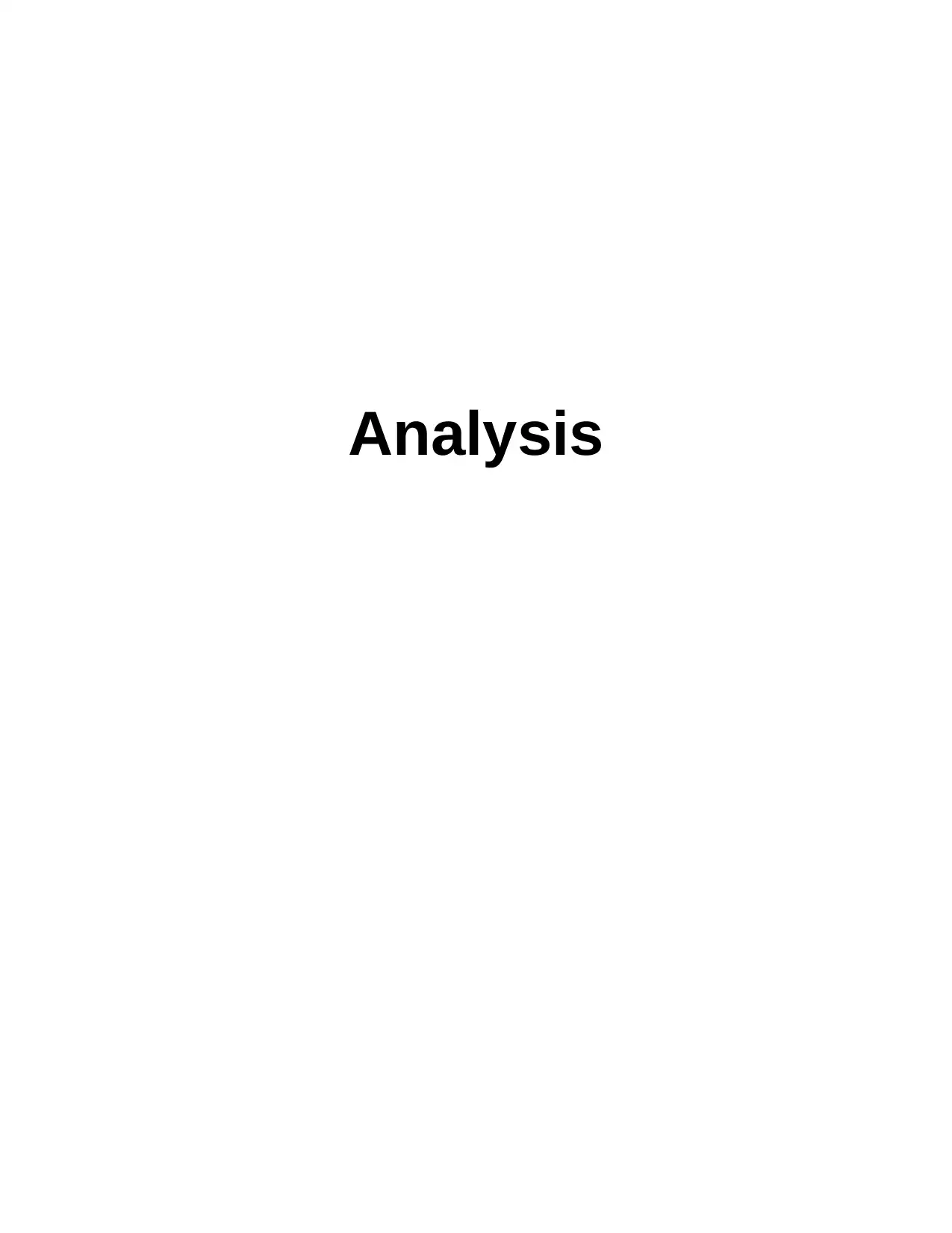
Analysis
Paraphrase This Document
Need a fresh take? Get an instant paraphrase of this document with our AI Paraphraser
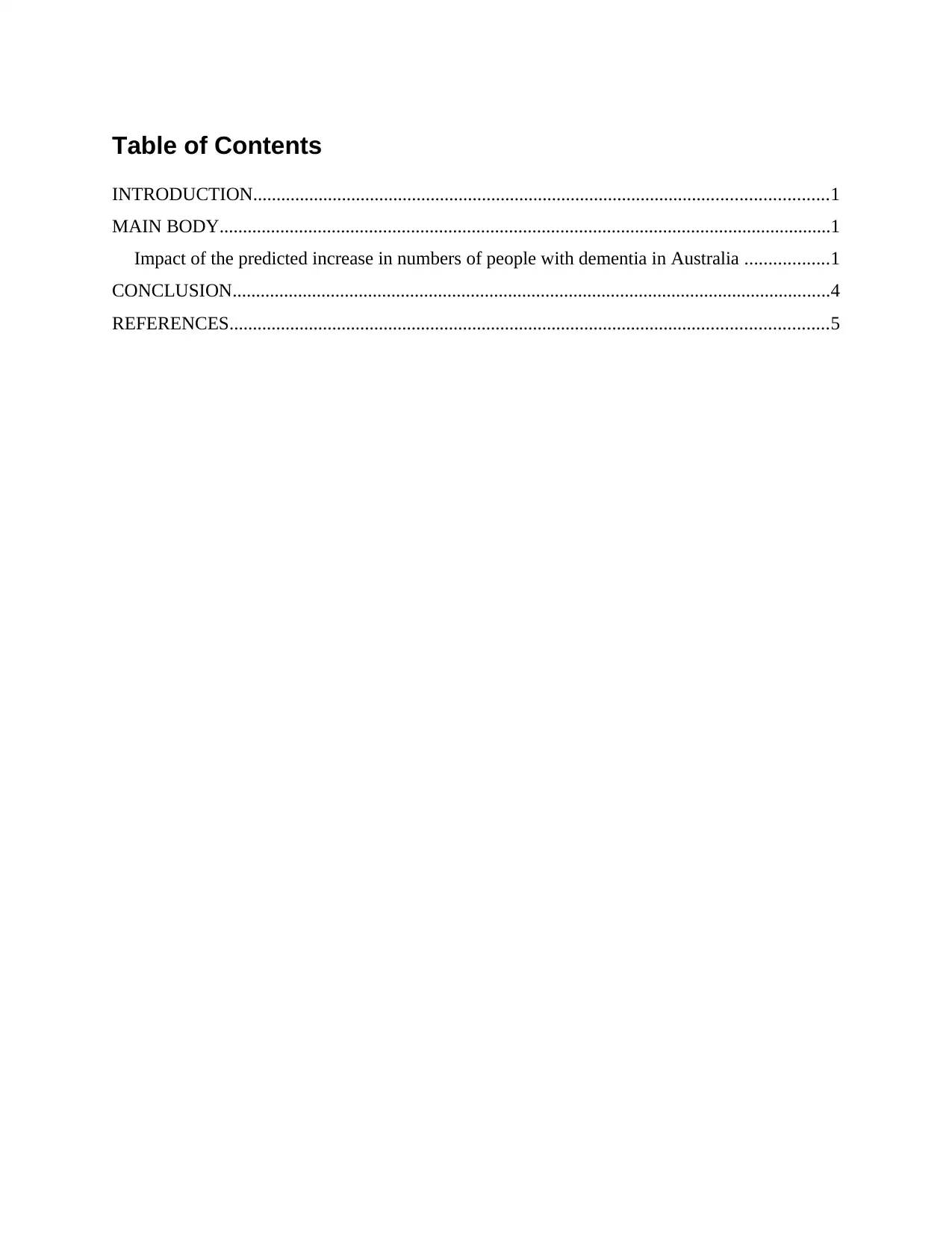
Table of Contents
INTRODUCTION...........................................................................................................................1
MAIN BODY...................................................................................................................................1
Impact of the predicted increase in numbers of people with dementia in Australia ..................1
CONCLUSION................................................................................................................................4
REFERENCES................................................................................................................................5
INTRODUCTION...........................................................................................................................1
MAIN BODY...................................................................................................................................1
Impact of the predicted increase in numbers of people with dementia in Australia ..................1
CONCLUSION................................................................................................................................4
REFERENCES................................................................................................................................5
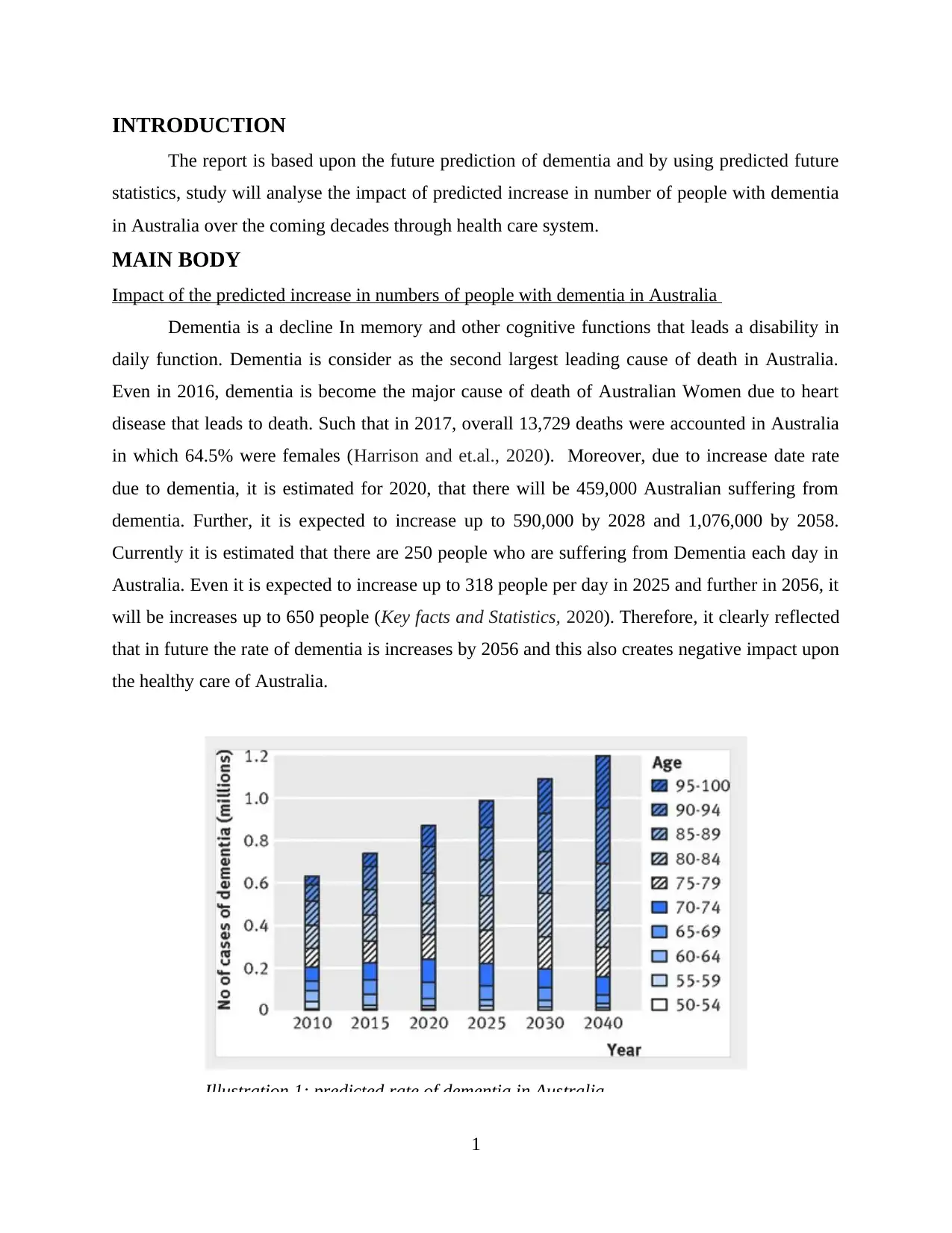
INTRODUCTION
The report is based upon the future prediction of dementia and by using predicted future
statistics, study will analyse the impact of predicted increase in number of people with dementia
in Australia over the coming decades through health care system.
MAIN BODY
Impact of the predicted increase in numbers of people with dementia in Australia
Dementia is a decline In memory and other cognitive functions that leads a disability in
daily function. Dementia is consider as the second largest leading cause of death in Australia.
Even in 2016, dementia is become the major cause of death of Australian Women due to heart
disease that leads to death. Such that in 2017, overall 13,729 deaths were accounted in Australia
in which 64.5% were females (Harrison and et.al., 2020). Moreover, due to increase date rate
due to dementia, it is estimated for 2020, that there will be 459,000 Australian suffering from
dementia. Further, it is expected to increase up to 590,000 by 2028 and 1,076,000 by 2058.
Currently it is estimated that there are 250 people who are suffering from Dementia each day in
Australia. Even it is expected to increase up to 318 people per day in 2025 and further in 2056, it
will be increases up to 650 people (Key facts and Statistics, 2020). Therefore, it clearly reflected
that in future the rate of dementia is increases by 2056 and this also creates negative impact upon
the healthy care of Australia.
1
Illustration 1: predicted rate of dementia in Australia
The report is based upon the future prediction of dementia and by using predicted future
statistics, study will analyse the impact of predicted increase in number of people with dementia
in Australia over the coming decades through health care system.
MAIN BODY
Impact of the predicted increase in numbers of people with dementia in Australia
Dementia is a decline In memory and other cognitive functions that leads a disability in
daily function. Dementia is consider as the second largest leading cause of death in Australia.
Even in 2016, dementia is become the major cause of death of Australian Women due to heart
disease that leads to death. Such that in 2017, overall 13,729 deaths were accounted in Australia
in which 64.5% were females (Harrison and et.al., 2020). Moreover, due to increase date rate
due to dementia, it is estimated for 2020, that there will be 459,000 Australian suffering from
dementia. Further, it is expected to increase up to 590,000 by 2028 and 1,076,000 by 2058.
Currently it is estimated that there are 250 people who are suffering from Dementia each day in
Australia. Even it is expected to increase up to 318 people per day in 2025 and further in 2056, it
will be increases up to 650 people (Key facts and Statistics, 2020). Therefore, it clearly reflected
that in future the rate of dementia is increases by 2056 and this also creates negative impact upon
the healthy care of Australia.
1
Illustration 1: predicted rate of dementia in Australia
⊘ This is a preview!⊘
Do you want full access?
Subscribe today to unlock all pages.

Trusted by 1+ million students worldwide
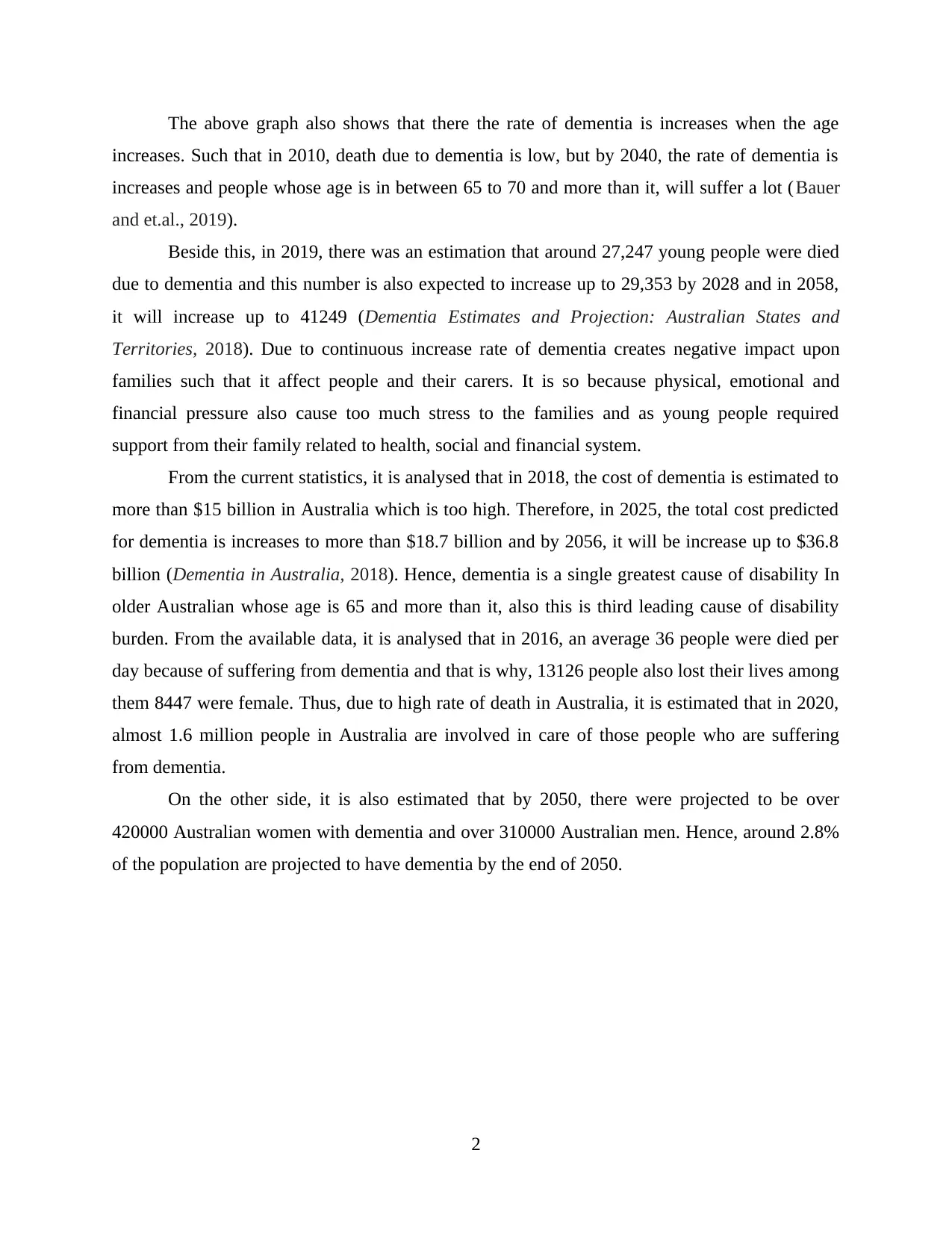
The above graph also shows that there the rate of dementia is increases when the age
increases. Such that in 2010, death due to dementia is low, but by 2040, the rate of dementia is
increases and people whose age is in between 65 to 70 and more than it, will suffer a lot (Bauer
and et.al., 2019).
Beside this, in 2019, there was an estimation that around 27,247 young people were died
due to dementia and this number is also expected to increase up to 29,353 by 2028 and in 2058,
it will increase up to 41249 (Dementia Estimates and Projection: Australian States and
Territories, 2018). Due to continuous increase rate of dementia creates negative impact upon
families such that it affect people and their carers. It is so because physical, emotional and
financial pressure also cause too much stress to the families and as young people required
support from their family related to health, social and financial system.
From the current statistics, it is analysed that in 2018, the cost of dementia is estimated to
more than $15 billion in Australia which is too high. Therefore, in 2025, the total cost predicted
for dementia is increases to more than $18.7 billion and by 2056, it will be increase up to $36.8
billion (Dementia in Australia, 2018). Hence, dementia is a single greatest cause of disability In
older Australian whose age is 65 and more than it, also this is third leading cause of disability
burden. From the available data, it is analysed that in 2016, an average 36 people were died per
day because of suffering from dementia and that is why, 13126 people also lost their lives among
them 8447 were female. Thus, due to high rate of death in Australia, it is estimated that in 2020,
almost 1.6 million people in Australia are involved in care of those people who are suffering
from dementia.
On the other side, it is also estimated that by 2050, there were projected to be over
420000 Australian women with dementia and over 310000 Australian men. Hence, around 2.8%
of the population are projected to have dementia by the end of 2050.
2
increases. Such that in 2010, death due to dementia is low, but by 2040, the rate of dementia is
increases and people whose age is in between 65 to 70 and more than it, will suffer a lot (Bauer
and et.al., 2019).
Beside this, in 2019, there was an estimation that around 27,247 young people were died
due to dementia and this number is also expected to increase up to 29,353 by 2028 and in 2058,
it will increase up to 41249 (Dementia Estimates and Projection: Australian States and
Territories, 2018). Due to continuous increase rate of dementia creates negative impact upon
families such that it affect people and their carers. It is so because physical, emotional and
financial pressure also cause too much stress to the families and as young people required
support from their family related to health, social and financial system.
From the current statistics, it is analysed that in 2018, the cost of dementia is estimated to
more than $15 billion in Australia which is too high. Therefore, in 2025, the total cost predicted
for dementia is increases to more than $18.7 billion and by 2056, it will be increase up to $36.8
billion (Dementia in Australia, 2018). Hence, dementia is a single greatest cause of disability In
older Australian whose age is 65 and more than it, also this is third leading cause of disability
burden. From the available data, it is analysed that in 2016, an average 36 people were died per
day because of suffering from dementia and that is why, 13126 people also lost their lives among
them 8447 were female. Thus, due to high rate of death in Australia, it is estimated that in 2020,
almost 1.6 million people in Australia are involved in care of those people who are suffering
from dementia.
On the other side, it is also estimated that by 2050, there were projected to be over
420000 Australian women with dementia and over 310000 Australian men. Hence, around 2.8%
of the population are projected to have dementia by the end of 2050.
2
Paraphrase This Document
Need a fresh take? Get an instant paraphrase of this document with our AI Paraphraser
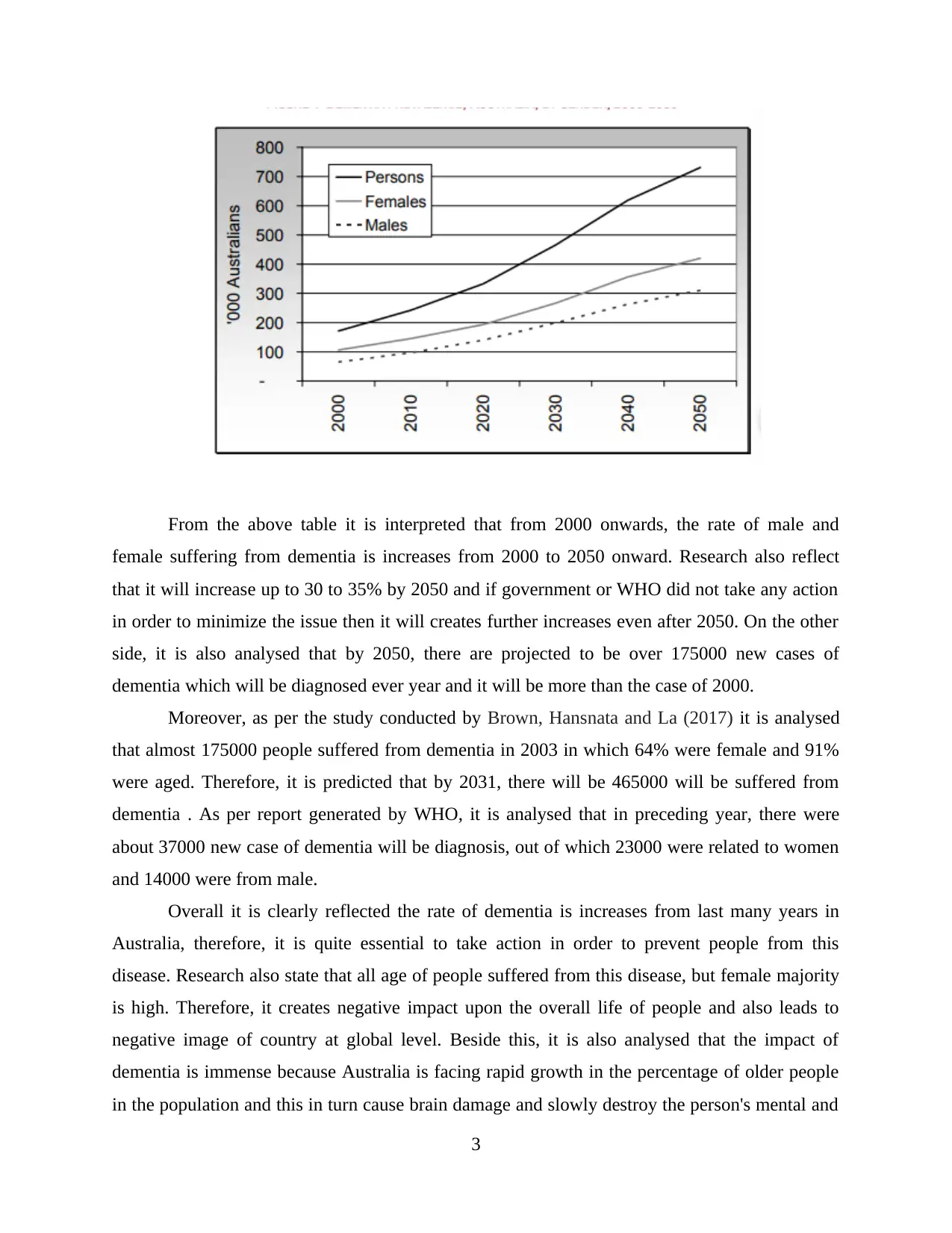
From the above table it is interpreted that from 2000 onwards, the rate of male and
female suffering from dementia is increases from 2000 to 2050 onward. Research also reflect
that it will increase up to 30 to 35% by 2050 and if government or WHO did not take any action
in order to minimize the issue then it will creates further increases even after 2050. On the other
side, it is also analysed that by 2050, there are projected to be over 175000 new cases of
dementia which will be diagnosed ever year and it will be more than the case of 2000.
Moreover, as per the study conducted by Brown, Hansnata and La (2017) it is analysed
that almost 175000 people suffered from dementia in 2003 in which 64% were female and 91%
were aged. Therefore, it is predicted that by 2031, there will be 465000 will be suffered from
dementia . As per report generated by WHO, it is analysed that in preceding year, there were
about 37000 new case of dementia will be diagnosis, out of which 23000 were related to women
and 14000 were from male.
Overall it is clearly reflected the rate of dementia is increases from last many years in
Australia, therefore, it is quite essential to take action in order to prevent people from this
disease. Research also state that all age of people suffered from this disease, but female majority
is high. Therefore, it creates negative impact upon the overall life of people and also leads to
negative image of country at global level. Beside this, it is also analysed that the impact of
dementia is immense because Australia is facing rapid growth in the percentage of older people
in the population and this in turn cause brain damage and slowly destroy the person's mental and
3
female suffering from dementia is increases from 2000 to 2050 onward. Research also reflect
that it will increase up to 30 to 35% by 2050 and if government or WHO did not take any action
in order to minimize the issue then it will creates further increases even after 2050. On the other
side, it is also analysed that by 2050, there are projected to be over 175000 new cases of
dementia which will be diagnosed ever year and it will be more than the case of 2000.
Moreover, as per the study conducted by Brown, Hansnata and La (2017) it is analysed
that almost 175000 people suffered from dementia in 2003 in which 64% were female and 91%
were aged. Therefore, it is predicted that by 2031, there will be 465000 will be suffered from
dementia . As per report generated by WHO, it is analysed that in preceding year, there were
about 37000 new case of dementia will be diagnosis, out of which 23000 were related to women
and 14000 were from male.
Overall it is clearly reflected the rate of dementia is increases from last many years in
Australia, therefore, it is quite essential to take action in order to prevent people from this
disease. Research also state that all age of people suffered from this disease, but female majority
is high. Therefore, it creates negative impact upon the overall life of people and also leads to
negative image of country at global level. Beside this, it is also analysed that the impact of
dementia is immense because Australia is facing rapid growth in the percentage of older people
in the population and this in turn cause brain damage and slowly destroy the person's mental and
3
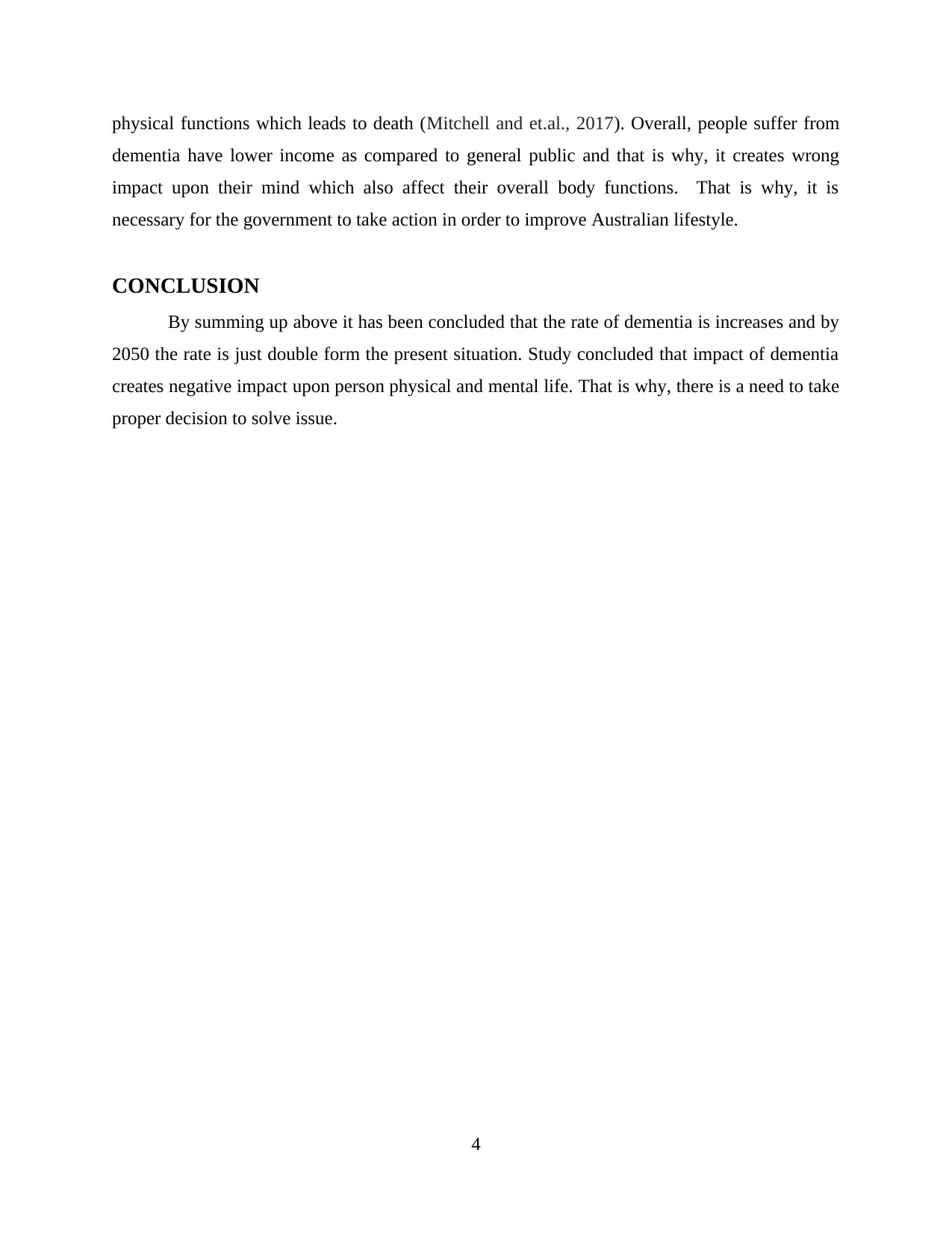
physical functions which leads to death (Mitchell and et.al., 2017). Overall, people suffer from
dementia have lower income as compared to general public and that is why, it creates wrong
impact upon their mind which also affect their overall body functions. That is why, it is
necessary for the government to take action in order to improve Australian lifestyle.
CONCLUSION
By summing up above it has been concluded that the rate of dementia is increases and by
2050 the rate is just double form the present situation. Study concluded that impact of dementia
creates negative impact upon person physical and mental life. That is why, there is a need to take
proper decision to solve issue.
4
dementia have lower income as compared to general public and that is why, it creates wrong
impact upon their mind which also affect their overall body functions. That is why, it is
necessary for the government to take action in order to improve Australian lifestyle.
CONCLUSION
By summing up above it has been concluded that the rate of dementia is increases and by
2050 the rate is just double form the present situation. Study concluded that impact of dementia
creates negative impact upon person physical and mental life. That is why, there is a need to take
proper decision to solve issue.
4
⊘ This is a preview!⊘
Do you want full access?
Subscribe today to unlock all pages.

Trusted by 1+ million students worldwide
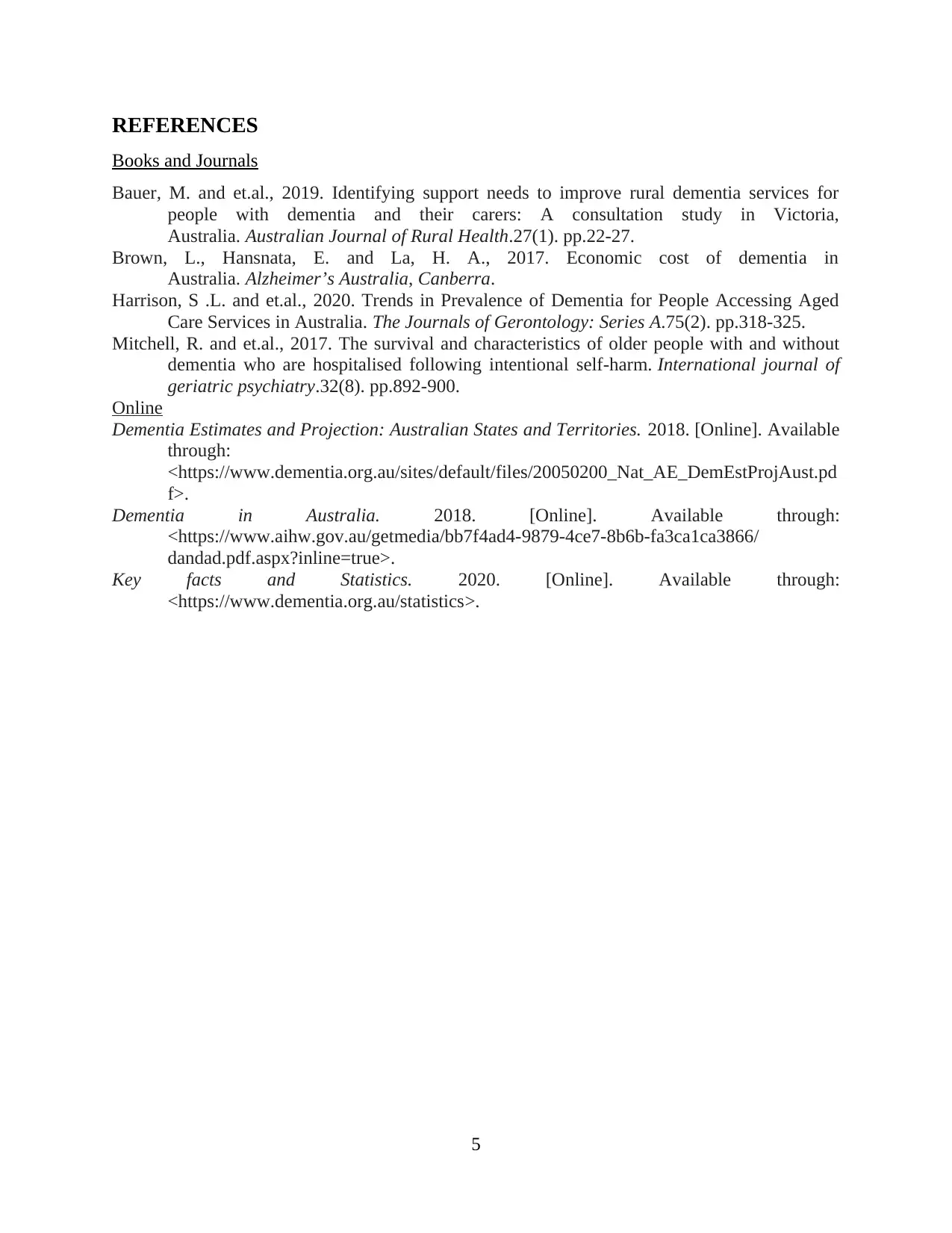
REFERENCES
Books and Journals
Bauer, M. and et.al., 2019. Identifying support needs to improve rural dementia services for
people with dementia and their carers: A consultation study in Victoria,
Australia. Australian Journal of Rural Health.27(1). pp.22-27.
Brown, L., Hansnata, E. and La, H. A., 2017. Economic cost of dementia in
Australia. Alzheimer’s Australia, Canberra.
Harrison, S .L. and et.al., 2020. Trends in Prevalence of Dementia for People Accessing Aged
Care Services in Australia. The Journals of Gerontology: Series A.75(2). pp.318-325.
Mitchell, R. and et.al., 2017. The survival and characteristics of older people with and without
dementia who are hospitalised following intentional self‐harm. International journal of
geriatric psychiatry.32(8). pp.892-900.
Online
Dementia Estimates and Projection: Australian States and Territories. 2018. [Online]. Available
through:
<https://www.dementia.org.au/sites/default/files/20050200_Nat_AE_DemEstProjAust.pd
f>.
Dementia in Australia. 2018. [Online]. Available through:
<https://www.aihw.gov.au/getmedia/bb7f4ad4-9879-4ce7-8b6b-fa3ca1ca3866/
dandad.pdf.aspx?inline=true>.
Key facts and Statistics. 2020. [Online]. Available through:
<https://www.dementia.org.au/statistics>.
5
Books and Journals
Bauer, M. and et.al., 2019. Identifying support needs to improve rural dementia services for
people with dementia and their carers: A consultation study in Victoria,
Australia. Australian Journal of Rural Health.27(1). pp.22-27.
Brown, L., Hansnata, E. and La, H. A., 2017. Economic cost of dementia in
Australia. Alzheimer’s Australia, Canberra.
Harrison, S .L. and et.al., 2020. Trends in Prevalence of Dementia for People Accessing Aged
Care Services in Australia. The Journals of Gerontology: Series A.75(2). pp.318-325.
Mitchell, R. and et.al., 2017. The survival and characteristics of older people with and without
dementia who are hospitalised following intentional self‐harm. International journal of
geriatric psychiatry.32(8). pp.892-900.
Online
Dementia Estimates and Projection: Australian States and Territories. 2018. [Online]. Available
through:
<https://www.dementia.org.au/sites/default/files/20050200_Nat_AE_DemEstProjAust.pd
f>.
Dementia in Australia. 2018. [Online]. Available through:
<https://www.aihw.gov.au/getmedia/bb7f4ad4-9879-4ce7-8b6b-fa3ca1ca3866/
dandad.pdf.aspx?inline=true>.
Key facts and Statistics. 2020. [Online]. Available through:
<https://www.dementia.org.au/statistics>.
5
1 out of 7
Related Documents
Your All-in-One AI-Powered Toolkit for Academic Success.
+13062052269
info@desklib.com
Available 24*7 on WhatsApp / Email
![[object Object]](/_next/static/media/star-bottom.7253800d.svg)
Unlock your academic potential
Copyright © 2020–2025 A2Z Services. All Rights Reserved. Developed and managed by ZUCOL.





